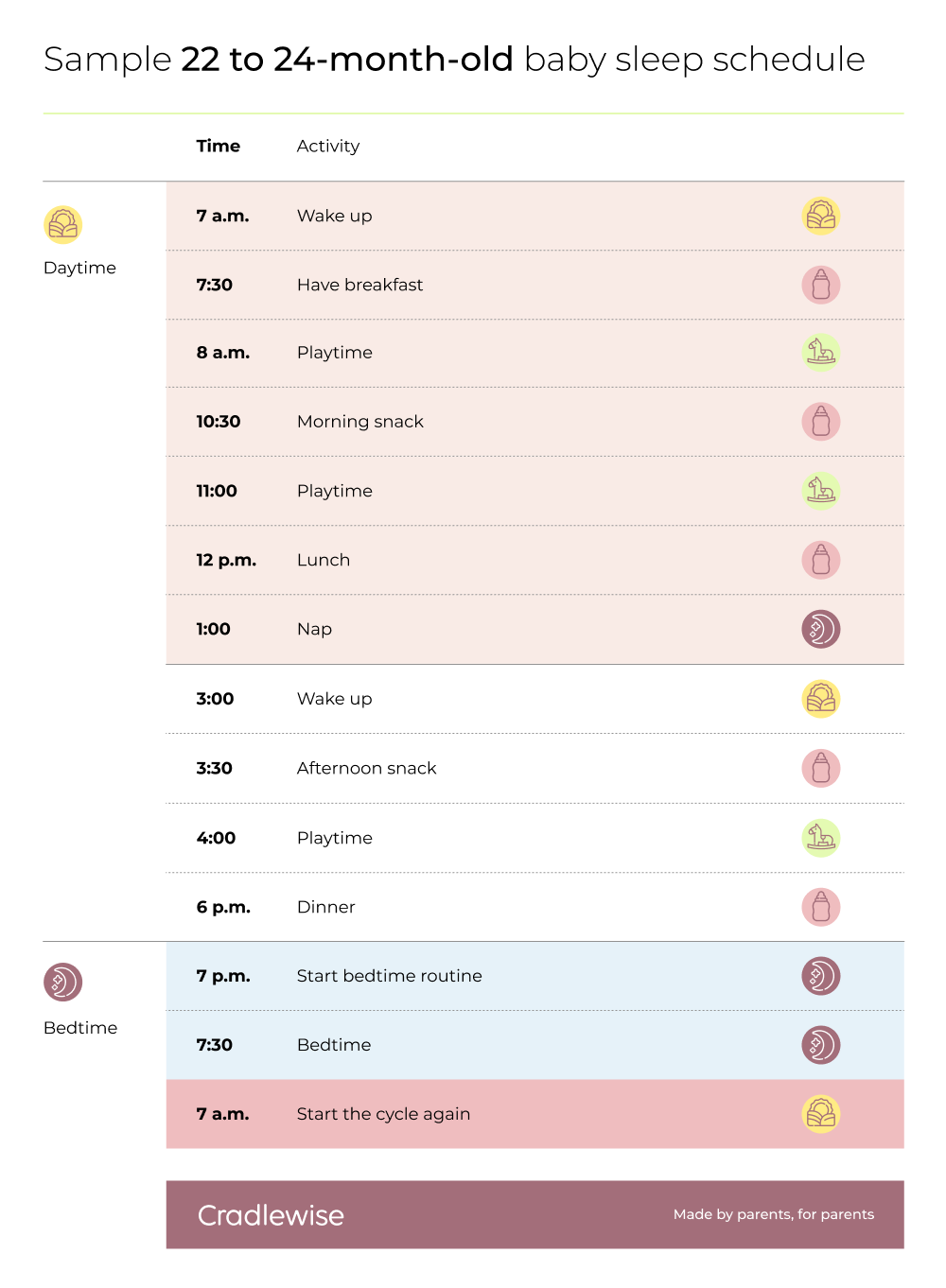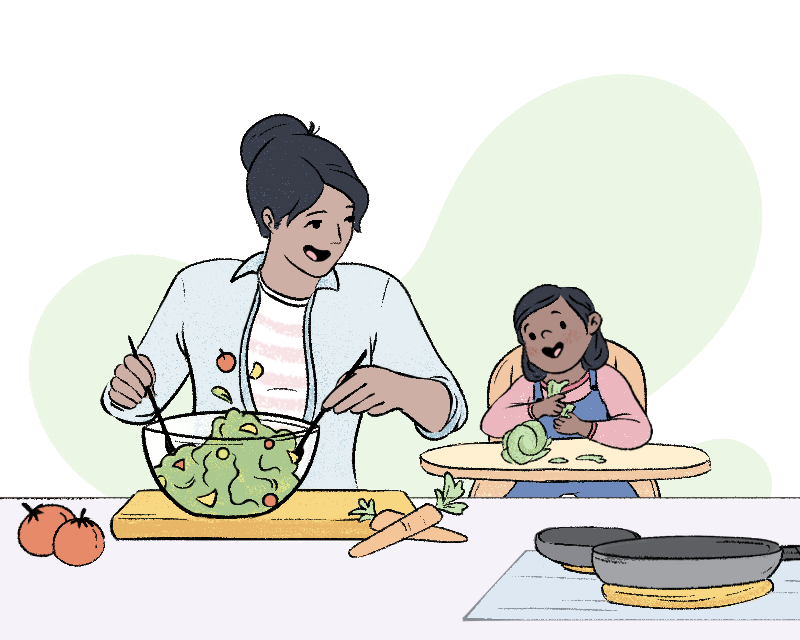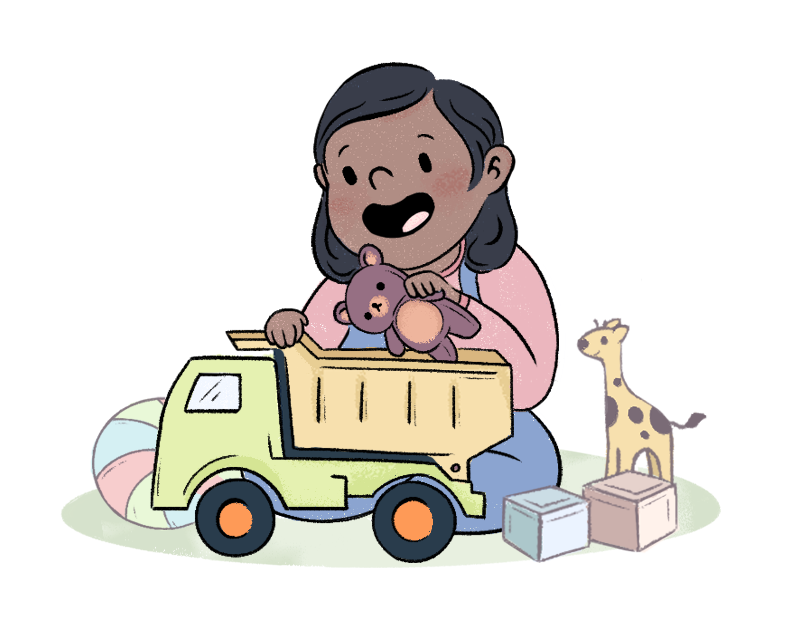
Night sleep
11 hours

Daytime naps
2-3 hours

Total sleep
11-14 hours
Happy birthday to your soon-to-be two-year-old! And while you may have heard rumors about the “terrible twos,” we promise that with the knowledge of what to expect during this time, two is pretty wonderful.
In your toddler’s second year of life, some changes may be ahead, such as transitioning from their Cradlewise smart crib to a bed or (yet another) sleep regression.
But this age can also be a lot of fun, with new discoveries and a whole lot of action-packed moments together.
Keep reading for more about what to expect from your toddler from 22 to 24 months of age, and other important milestones, including sleep, development, and nutrition.
22 to 24-month toddler milestones for sleep
At 22 to 24 months, your toddler is likely becoming increasingly independent and physically active.
You might start to hear the infamous toddler refrain of “Me do!” when they want to try doing everything by themselves.
To help them explore their independence, gain new skills, and build confidence without constant battles—especially at nap and bedtimes— it might help to give simple choices.
For example, set out two pajamas and let your toddler decide which pair to wear. Let your toddler know how many books you will read together, and then let them choose the books.
Or, encourage your toddler to participate in setting the scene for a good night’s sleep, such as turning off the light, turning on the fan, and turning on the night light.
Around 24 months, your child may experience another sleep regression. As a reminder, sleep regression is when a child who was previously sleeping well experiences a return to earlier sleep patterns, such as waking up more frequently in the night.
Sleep regressions can occur for a variety of reasons, including as a response to stress (did a new baby join the family?) or along with the achievement of other developmental milestones.
They’re also a normal and expected part of toddler development and are a sign that your child is developing on track.
But while they may be common, sleep regressions can be highly frustrating for you and your now overtired toddler.
The best way to work through a sleep regression is to remember that it will pass, don’t panic, and stay consistent. Most likely, after a few weeks, your toddler will return to sleeping normally.

Cradlewise Smart Crib
Smarter Sleep for Your Baby
An award-winning crib—loved by parents, approved by experts.
0 to 24 months of use
Automatic soothing
Built-in video & sound machine
AI-powered sleep insights
Customizable soundtracks
Get 2 extra hours of sleep nightly
What’s going on in your toddler’s brain?

Nothing is more peaceful than a sleeping toddler, but sleep is actually when a tremendous amount of work occurs.
Everything from physical growth to brain development to cellular “clean-up” occurs during sleep, so it’s important to prioritize those precious hours.
But what milestones can you expect your toddler’s brain to be working on right now?
According to the Centers for Disease Control and Prevention (CDC), some of the milestones you will begin to see in your 22- to 24-month-old include:
- Running
- Jumping
- Kicking a ball
- Walking (not crawling) up steps with or without help
- Blowing a kiss
- Using 2 toys together, such as putting a stuffed animal into a toy car
- Saying 2 words together, such as “Go play”
- Noticing emotions in others, such as looking at you to see how you will react to a situation
- Pointing to body parts when you name them
- Pointing to things in a book when you ask
- Eating with a spoon
- Playing with more than one toy at a time
How much should a 22- to 24-month-old sleep?
For toddlers between the age of 1 and 3 years, the total amount of time spent asleep, including naps, over a 24-hour period will not change too much.
However, the number of naps your toddler may take might change, especially as they get older. By 22 to 24 months, your toddler has likely transitioned to only one nap per day.
According to the CDC, your toddler should get a total of 11 to 14 hours of sleep each day, including nighttime sleeping and naps.
- Total hours of sleep: 11 to 14 hours
- Wake windows: 5-6 hours
- Number of naps: 1 nap
Sample sleep schedule for a 22- to 24-month-old toddler
Most toddlers will wake up between the hours of 6:30 and 8:00 AM, according to the Journal of Sleep Research.
Some toddlers will naturally wake earlier, while others might sleep in, so keep in mind that this sample schedule is just that—a sample!
You can tailor your toddler’s sleep schedule to fit your own family’s life, but the important thing is to make sure your child is still getting that recommended 11-14 hours of sleep.


22-24 month-old feeding tips

A healthy diet for a toddler between the ages of 22-24 months should consist of the same foods you eat, including a variety of fruits, vegetables, grains, and proteins.
If your toddler has decided that they are only interested in eating a few favorite foods and refusing everything else, don’t worry—that’s totally normal for toddlers.
Simply continue to offer different foods until your child is intrigued and discovers their next favorite thing.
Even if you are breastfeeding your toddler, breast milk is a supplement and is not the sole source of nutrition for your toddler.
The American Academy of Pediatrics is in support of continued breastfeeding, if desired by both the caregiver and toddler, until age 2 and even beyond.
As far as other beverages go, stick to water and full-fat milk (more on that later).
Avoid sugar-sweetened beverages such as juice as much as possible, according to the AAP, but if you do give your toddler juice, it should be 100% juice and limited to 4 ounces per day.
This is also a great age to start getting your toddler more involved in the kitchen, which can not only help foster their independence and development but can also help them develop more positive nutrition habits.
Getting a toddler’s “help” in the kitchen will most likely just cause more stress, but there are some simple ways to get the whole family involved. For instance, if you are making a salad for dinner, you could give your 22- to 24-month-old a piece of lettuce to tear up. Or offering a few pieces of cooked and cooled pasta could entertain your child while you are preparing dinner.
Sitting down as a family for a meal will also provide some of the structure and routine a child needs at this age.
- How much should a 22- to 24-month-old eat? According to the American Academy of Pediatrics (AAP), toddlers between one and three years of age need about 1,000 calories per day.
It is also important not to restrict fat from your toddler’s diet as fats are essential for their development. About half of the calories should come from fat, which you can easily achieve by choosing full-fat foods, such as full-fat milk, yogurt, and cheeses.
Other healthy sources of fat include avocado, nut butter, and fatty fish.
- How much should a 22- to 24-month-old weigh? According to the World Health Organization growth charts:
- 24.5 pounds, for a 22-month-old girl in the 50th percentile for weight
- 25.3 pounds, for 24-month-old girl in the 50th percentile for weight
- 26 pounds, for a 22-month-old boy in the 50th percentile for weight
- 27 pounds, for a 24-month-old boy in the 50th percentile for weight
- How often should a 22-v to 24-month-old eat? The 1,000 calories your toddler eats in a day is best divided into three meals and two snacks per day.
However, toddlers are known for irregular eating so you might notice they are extra hungry in the morning one day and then not eating much during the rest of the day.
Erratic eating is pretty normal for toddlers, but you can help ensure they’re getting enough nutrients by offering a variety of food choices throughout the day.
You can also encourage eating at meal and snack times, but never force your toddler to eat food if they’re not hungry or finish food they don’t want to eat. Healthy habits start by encouraging kids to honor their own natural hunger cues.
How to help support your toddler’s sleep at 22-24 months

1. Allow plenty of transition time
1. Allow plenty of transition time
You may need to build a few extra minutes into your toddler’s bedtime routine to account for transition time from one activity to the next, especially if your toddler is making important choices such as which pajamas to wear and which stuffed animal to sleep with. You can also keep things very simple, such as not outlining each step ahead of time, but instead walking your toddler through each step one at a time.
2. Expect a sleep regression
2. Expect a sleep regression
Your two-year-old suddenly resisting their afternoon nap most likely does not mean that they’re ready to stop napping. Instead, a new nap resistance is probably just that infamous 24-month sleep regression rearing its head. A 2016 review in Sleep Health explains that 91% of two-year-olds are still napping daily, so you have statistics on your side—stay strong and ride the sleep regression wave, because chances are, your toddler will go right back to napping soon.
3. Look for crib-to-bed transition cues
3. Look for crib-to-bed transition cues
The Cradlewise crib is designed for use up to 24 months, so around this time you may be wondering when your toddler will be ready to transition from their Cradlewise to a toddler bed.
You could consider switching your toddler from a crib to a toddler bed if they’re showing signs of climbing, if they’ve successfully climbed out of the crib before, or if you’re in need of the crib for another new family member.
The AAP recommends considering making a transition to a toddler bed when your toddler is climbing out of their crib. (One of the most shocking moments in a parent’s life can be the first time you’re woken up in the middle of the night to find your toddler mysteriously standing in the middle of your room!)
4. Be cautious with sleep supplements
4. Be cautious with sleep supplements
You have likely heard of the benefits of the supplement melatonin to assist with falling asleep for both adults and children. However, melatonin use in children has been associated with serious events including pediatric hospitalizations.
If you’re considering trying melatonin with your child, be sure to talk to your pediatrician first. A doctor may also be able to help you determine if there are any other medical conditions that could be contributing to sleep disruptions in your child. And if you’re using melatonin supplements for yourself or other adults in the house, be sure to store them far out of reach of your child.
5. Limit screen time
5. Limit screen time
We couldn’t let you finish reading an article about sleep in toddlers without addressing screen time, right? The type of blue light emitted from devices such as tablets and phones is responsible for tricking the brain—of both adults and toddlers—into thinking it is daytime instead of nighttime. Additionally, high daily screen time amounts and evening screen time have also been associated with worse sleep outcomes in toddlers, such as shorter total sleep duration and a later bedtime.
To help ensure that your toddler can fall asleep when they need to, the AAP recommends avoiding screens for at least an hour before going to bed. And honestly, that might be a recommendation that we could all use!
Sources:
- Pediatric sleep recommendations. 2016. Journal of Clinical Sleep Medicine. Recommended Amount of Sleep for Pediatric Populations: A Consensus Statement of the American Academy of Sleep Medicine
- Sleep regression. Sleep Florida. Sleep regression: what it is and how to handle it.
- 24-month-old milestones. Centers for Disease Control and Prevention. Important Milestones: Your Baby By Two Years.
- Sleep recommendations for infants and toddlers. 2023. Centers for Disease Control and Prevention. How Much Sleep Do I Need?
- Toddler wake times. 2016. Journal of Sleep Research. Development of infant and toddler sleep patterns: real-world data from a mobile application.
- Nutrition for toddlers. Nemours Kids Health. 2018. Nutrition guide for toddlers.
- Breastfeeding recommendations. 2022. American Academy of Pediatrics. Policy Statement: Breastfeeding and the Use of Human Milk.
- Beverages for toddlers. 2018. American Family Physicians. Nutrition in Toddlers.
- Cooking with kids. 2022. Current Developments in Nutrition. Cooking With Kids: A Preliminary Conceptual Model of Child Involvement in Home Food Preparation and Diet Quality.
- Family mealtime. 2021. American College of Pediatricians. The Benefits of the Family Table.
- Feeding and nutrition. 2020. American Academy of Pediatrics. Feeding and Nutrition tips.
- Food and drink amounts. 2020. American Academy of Pediatrics. Energy in: Recommended food and drink amounts for children.
- Growth charts. World Health Organization. Weight-for-age charts.
- Toddler naps. 2016. Sleep Health. Toddler naps in childcare.
- Melatonin. 2022. CDC. Pediatric melatonin ingestions.
- Melatonin and screen time. 2022. American Academy of Pediatrics. Melatonin for kids.
- Screen time and sleep. 2020. Sleep Medicine Reviews. Associations of screen time, sedentary time and physical activity with sleep in under 5s: A systematic review and meta-analysis.
You may also like





